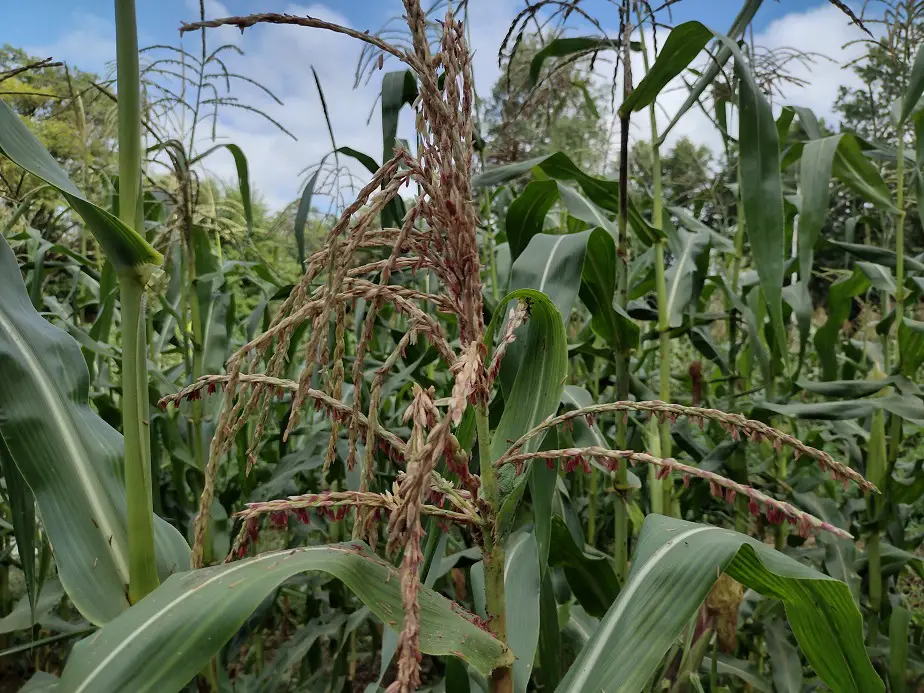Corn is the highest yielding grain that grows in our region. It’s high-calorie, nutritious, and stores well. Tastes good too.
In Michigan, corn is planted between May 18th and June 10th. Farmers usually have to plant their field corn by June 5th, but gardeners often plant corn later in June. Field corn takes around 115-120 days of good growing weather, and Sweet corn usually takes around 80 days in our climate.
I’ve grown various types of corn for a number of years and have had multiple failures and successes. Here’s what I’ve learned.
Planting and Growing Corn in Michigan
Corn is planted after the soil has warmed up to a minimum 50 degrees and the threat of frost is past. Many growers prefer a soil that is 55 or even 60 degrees for better and more even germination. Planting earlier or falling at all outside of those parameters will result in some problems.
It has to have proper soil nutrients, at least decent soil, and at least 20 inches of rainfall or irrigation throughout the season to have a good harvest. For me, the biggest problem has been getting the planting time right.
There are three big reasons why corn doesn’t do well when planted early in Michigan. A frost will usually hurt young corn. A single deep freeze night will kill a lot of it. A study in the 90s showed that corn often dies after a few hours at 32 degrees, and after a few minutes at 28 degrees.
All it takes is a slight shift in wind direction for the spring temperature to drop 5 degrees colder than expected. Even if it seems like you could plant early, oftentimes it’s not a good idea, at least for direct planting. Small scale, some people start corn indoors in growing trays and transplant at 2-3 weeks old.
That’s the only way to get an early start really. Well, that or planting in a greenhouse/hoop house. I do know one guy who plants sweet corn in a greenhouse to get it to market a month early. Being the only guy with early sweet corn, he charges a premium price and says it’s worth it.
The, probably bigger, issue with early planting is that we will still have quite a few cold nights and cold days, even if frost is past. If after planting, the soil goes back down near 40 degrees, growth gets all messed up. I experienced that pretty bad last year. It wasn’t good.
We had a rough year with uncertainty, and a warm spring so I planted early. The weather turned overcast and got cold again for a week or so, and the corn suffered. Prolonged cold snaps after planting tend to cause uneven emergence. That means the plants will grow and mature unevenly.
That causes poor pollination and a significantly lower yield than normal. I harvested at best a 30 percent yield. It was just enough to save seed, and have a little for the chickens. That was all my fault. I knew better, took a gamble, and lost. Don’t gamble with your harvests.
This year, I planted in good weather, had superb emergence, and the pollination looked great. I’m excited to see the harvest in the coming month or so. It looks like it will be enough corn for the pigs, chickens, and us this year.
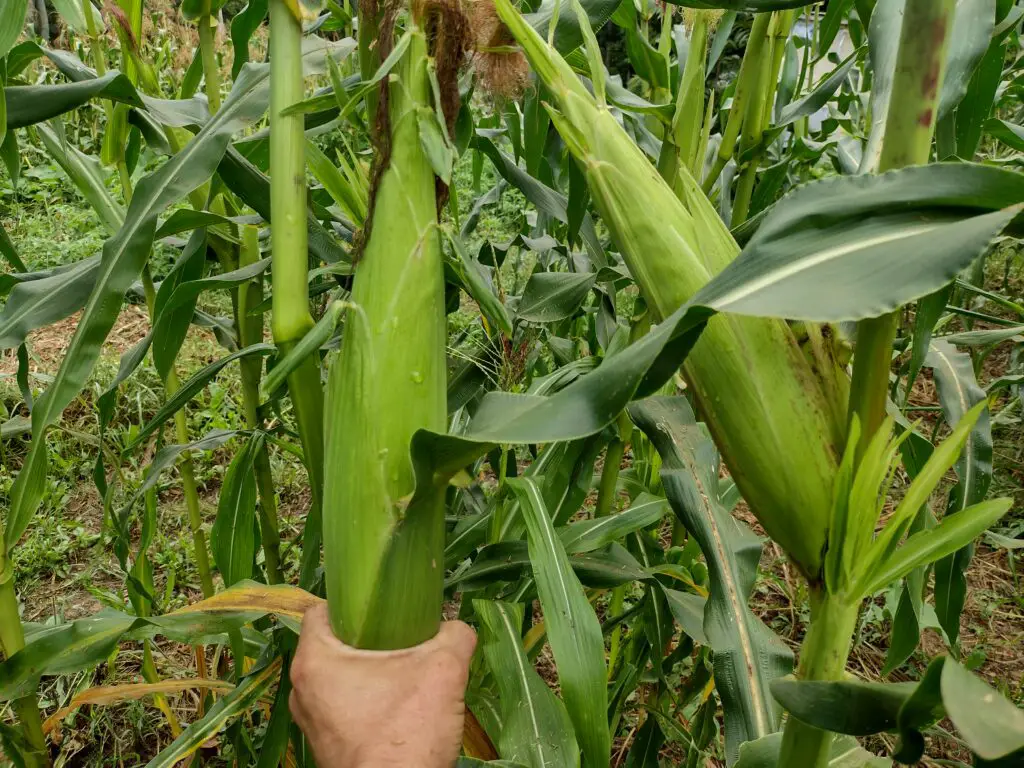
What Type of Corn Grows Best in Michigan?
Usually, any corn with less than 110 days to maturity will grow well in Michigan. Flint corn types were originally developed for the more northern climates, favoring the cooler weather and shorter season. Modern dent corn, like Bloody Butcher and many hybrids, have those cool weather genes bred into them.
I like growing flint corns. They are hardy, usually higher in protein, and I think they make better grits. But, they tend to take a longer growing season and can be tougher to dry out. The most popular heirloom corn is Bloody Butcher, a deep-red dent corn with a good yield potential.
I like a flint corn called Wade’s Giant Indian, which was developed in Macomb County, MI. It likes the weather here but has a long growing season so it cannot be planted late at all if I want it to dry in the field. It’s the highest-yielding flint corn I’ve seen, so I’m trying to learn to make it work.
It grows very large ears, and the stalks are up to 12 feet tall. I like it because it yields a lot of food and because it grows a lot of leaf and stalk material that i can compost and put back into the soil.
This year, we’re growing a variety of flint corn called Pink Popcorn, or Early Pink Popcorn. It’s a smaller variety, that yields decently if planted a bit closer, and it takes less fertilizer. It’s growing quite well and the ears are filing out nicely so far with little fungal issues.
Any sweet corn grows great in Michigan since it doesn’t a long season to mature and dry out in the field. Personally, I don’t grow sweet corn because it has a low feed value. I prefer the higher calorie corns. After all, we’re growing food for ourselves and the animals here.
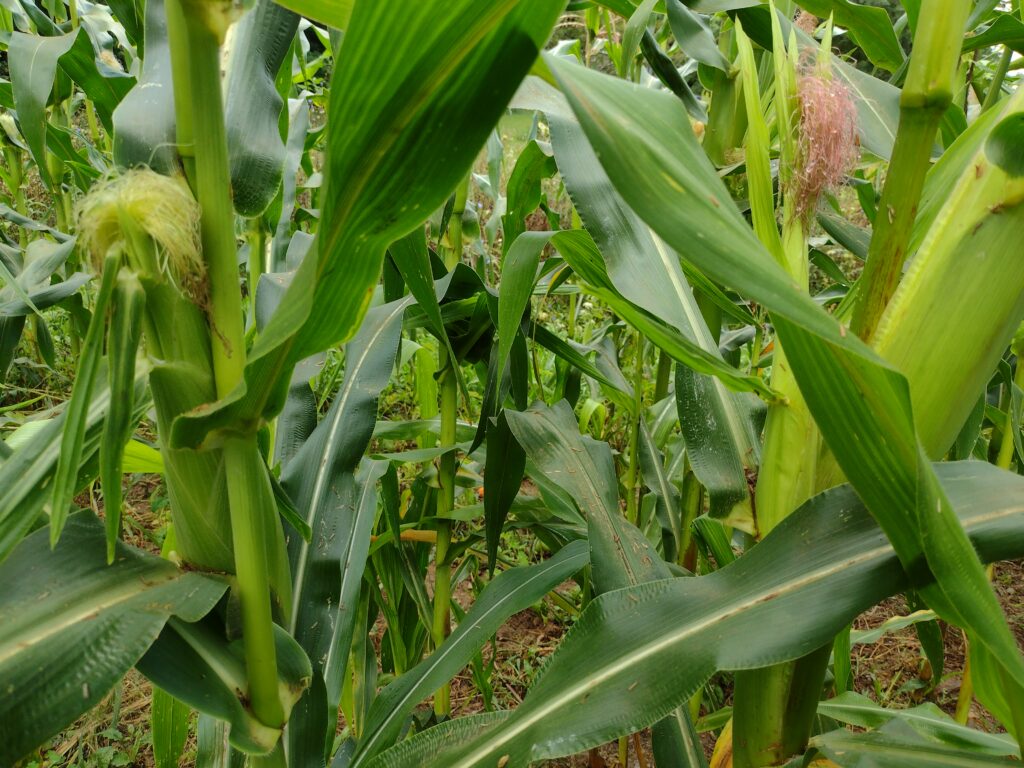
How to Plant Corn
The first thing you need to do is figure out what variety you want to grow and how much seed you will need. This greatly depends on plant spacing and row spacing.
The Rule of thumb is large varieties of corn should be 12 inches apart, regular field corn can be 8-10 inches apart, and smaller popcorns and sweet corns are planted 6-8 inches apart.
Corn rows should not be more than 3 feet apart and not much closer than 2 feet. Rows closer than 20 inches have shown a significant decrease in yield. The closer you plant your rows, the more spacing between plants you should give them.
Corn planted too closely will dry out the soil and compete for light, growing weaker, scrawnier stalks that are susceptible to wind damage, and will yield less corn.
100 feet of row space usually takes about 2 ounces of dent corn, flint corn, or popcorn seed, and 4 ounces of sweet corn seed. 25,000-35,000 corn seeds are planted per acre. 10-20 pounds of seed are required per acre, depending on seed size. Sweet corn and popcorn are usually planted more densely.
For my large variety flint corn, I like 12-inch plant spacing with 24-inches between rows. For my popcorn, I planted them 7-8-inches apart with 24-inches between rows. Realize that the tighter you plant them, the more you pack them in; the more water and fertilizer they will be needing too. Don’t overdo it.
Corn planted too closely will not get enough light, nutrients, or water, and will not be able to spread their roots. Avoid crowding them in too closely. I used to plant my corn by hand. I walked down a row and poked holes with my fingers, dropped a seed, and repeated every 8-12 inches. That was tedious.

It worked, and I could plant a 50×50 plot in around an hour if the soil was prepared enough. Currently, I use an older model Earthway Seeder that I bought used. I can now do a 50×50 plot in 5 minutes. If the soil is smooth and I’m going right along, I could probably plant a 1-acre plot in 2 hours with it.
Not too bad for a small operation. That means If I needed to, I could plant several acres with it in a day before collapsing. Seed Planters like the Earthway, the Hoss Seeder, and the Jang are really all the smaller homestead would ever likely need. They plant much more uniformly than by hand, which improves yield.

Testing Soil and Fertilizing
Corn needs somewhere near 200 pounds of nitrogen per acre,100-lbs. phosphorus, and 170-lbs. potassium per acre. Those are the three nutrients that are usually lacking in the soil to grow good corn. In sandy soil, it takes more because there is no organic matter to hold the nutrients in the soil.
Excessive rain or irrigation will flush nutrients out of your soil. Applying granular fertilizer to the top of the soil may end up allowing it to be washed away in top runoff during heavy rain. And, the condition of your soil, its current nutrient levels, may require more or less fertilizer.
There are a lot of variables when you add them up. Fortunately, it’s fairly simple to track and monitor. All you really need to do, unless you have very sandy soil, is a DIY soil test. If you do have very sandy soil, start building up quality topsoil as fast as you can. The LusterLeaf 1602 soil test kit is the one I recommend.
It’s under $20 bucks on Amazon and will do a lot of tests. If your soil tests halfway or under using that test kit, add 1/2 pound nitrogen per 100 row-feet. For a 10-10-10 strength fertilizer, that’s 10 pounds. For 13-13-13 fertilizer, that’s 7 1/2 pounds, and for a 20-20-20, that’s 5 pounds.
You need to test your soil at least two weeks before planting. If the NPK comes back quite low, do the full fertilizer regimen. If it’s already halfway, do half a dose of fertilizer and see how the numbers change. You really should do a second soil test when the corn is just knee high to see where the fertility is at.
Personally, I like to use a mix of two fertilizers because it better suits the needs of corn. The problem with regular, even NPK fertilizer is that it’s incredibly unbalanced for corn. If I were to put corn NPK (nitrogen, phosphorus, potassium) needs in a proper ratio, it’s about 2-1-1.5.
Using a regular, balanced number fertilizers for consecutive years tends to cause excessive Potassium build-up, which hurts overall fertility. I like to fertilize just before or after planting with a 20-20-20, but at 75 percent of the full rate. That’s 3 pounds and 12oz per 100 row feet.
Then, when the corn is knee tall (a bit taller for big varieties) I apply an additional pound of Urea per 100 feet, which has an NPK of 46-0-0. If my soil Test shows the P and K are decent but nitrogen is lacking (somewhat common in my soil) I’ll use half as much 20-20-20 and more urea.
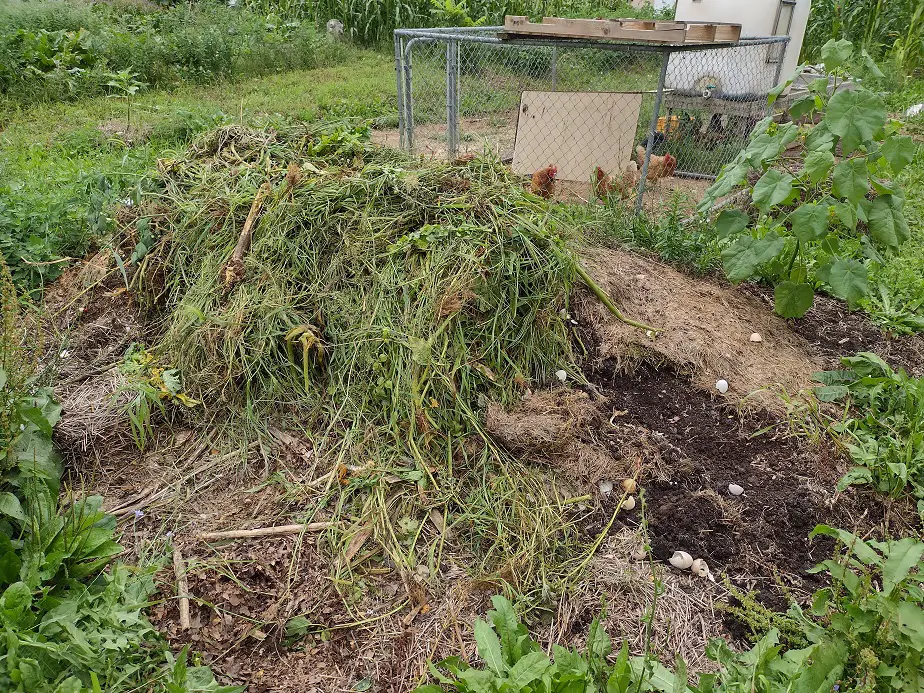
Creating the Best Soil for Corn
The most important aspect of growing anything is good soil. Corn is no exception. There’s no secret that plants do better in good soil. Ideally, good soil has a base that’s sandy and silty soil with a little clay in it, and high in organic matter.
No matter what your base soil is, a high organic matter content will fix it up really nicely. I like soil with organic content anywhere between 5 and 10 percent. That’s pretty high and usually takes some dedicated work to reach. My topsoil has between 4 and 6 percent organic content. I’m working on it.
I’ve been adding manure and some bulk-purchased compost, fall leaves, grass clippings, and almost anything else that will break down in the soil. My soil started out at 1/2 percent organic content, so I’ve made a lot of progress. It would be a good idea to get a professional soil test.
In Michigan, you can order one from the MSU agricultural extension for around $30 bucks. If you haven’t ever had one done, you should go ahead and get one so you know for sure is any base soil minerals happen to be lacking
Tips for Field Corn
For field corn, just be sure that it’s got enough time to dry out before winter. A local farm manager recommended an 85-day corn to be sure it has enough time to dry out before the sunlight hours get too short in the fall. Really, that’s the only special thing bout field corn.
Tips for Indian Corn
For Indian corn, unless you’re selling it as a decoration, you need it to dry well. We grow it for animal feed and to make cornmeal. Most Indian corn has a maturity season of at least 100 days, so it’s more important not to plant too late.
If you want it to have nice brown stalks for selling as decoration, you may want to cut off irrigation after it tassels out. That will force it to mature a bit early and help it go brown and dry out quicker. Generally, Indian corn between 100 and 110 days is quite functional.
Tips for Popcorn
Popcorn is very moisture sensitive and needs to be well-dried. Ideally, you want a 15 percent moisture content of the kernels to get a good pop. Also, it’s advised not to use a standard corn harvester to pick it. Normal ones tend to damage the kernels, lowering the popping rate.
Small stands of popcorn are picked and shelled by hand, and that works great. For larger areas, you should find a picker that has a setting for popcorn. That way it will handle the smaller ears and kernels, and won’t damage them. For best results, wait until the stems are fully dried out before harvesting.
Tips for Sweet Corn
Sweet corn, when planted at the normal corn planting time, is usually harvested mid to late August. Sweet corn can lose up to half its sugar content 24 hours after being picked, so if you want the absolute best, don’t pick it until the day of eating or selling at the market.
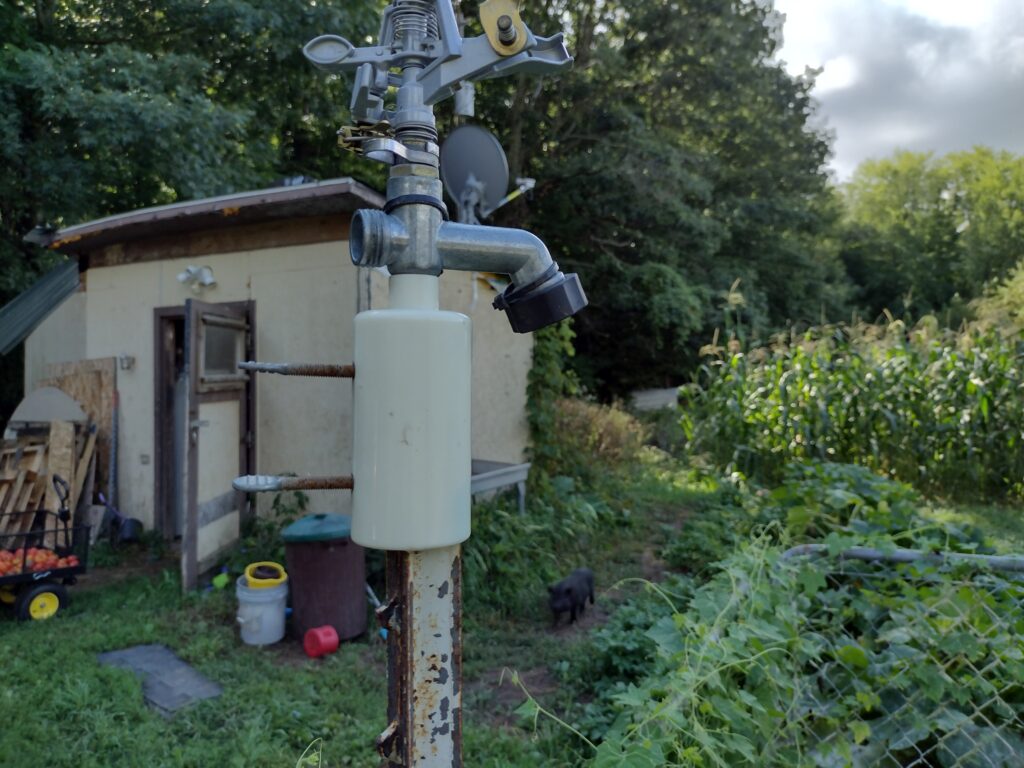
Small Scale Irrigation of Corn
For small-scale irrigation, I recommend an impact sprinkler mounted on a tall t-post. I like to use a 7-foot post, which will be about 6 feet tall when I set it. That way, the water will go further and won’t get blocked by tall corn. When watering, try to get 1-2 inches at a time.
Take a couple 5-gallon buckets and set them out in the spray zone and see on average how much water they collect in 30 minutes, an hour, and 2 hours. For me, about 1 hour is an inch of irrigation when running 2 impact sprinklers at once, not overlapping spray zones.
Corn needs at least 20 inches of irrigation to get a functional harvest. 30 inches is considered more than sufficient. Most of Michigan gets between 20 and 30 inches a year, so that’s good. The issue is that we sometimes get a dry spell when corn needs water most.
Corn needs to stay well-hydrated up until the tassels fill out at the top of the stalks. at that stage, they still need plenty of water, but it’s arguably less important than during the green growth stage. In Michigan, we usually see short droughts in June or July.
Generally speaking, your corn should get at least an inch of water a week from June through July. If it’s been dry and your soil is getting dusty, it may be time to irrigate. I used to use a hose and simply spray water into the corn when it got dry. The sprinklers save me valuable time now.
For best yields, corn shouldn’t really dry out until after the cornsilks go brown. at that point, the plant is fully grown, pollination worked, and the bulk of the ear of corn has developed. That’s when you can take it easy, usually. Just don’t let it get so dry that it dies off early if you can help it.
Once the corn is waist-high, it can handle some short-term moderate drought conditions. If you can help it, don’t let it ever dry out until it’s at least knee-high. Corn needs to stay hydrated and young corn has a small root system that dries out quickly.
Related articles:

